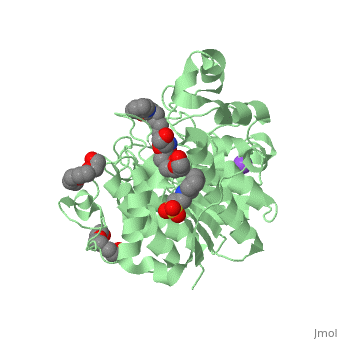Elizabeth A. Dunlap/Sandbox 1
From Proteopedia
(Difference between revisions)
| Line 5: | Line 5: | ||
== Function == | == Function == | ||
| - | Vorinostat (Zolinza) is an oral drug used as a cancer therapy to treat cutaneous T-cell lymphoma (CTCL). Vorinostat, previously known as suberoylanilide hydroxamic acid (SAHA), was the first HDAC inhibitor to be approved by the U.S. Food and Drug Administration on October 6, 2006. Cancer cells tend to over-express histone deacetylase (HDAC). HDAC removes acetyl groups on histones which results in a structural change of chromatin. This change in chromatin structure leads to the repression of gene expression which would result in the proliferation of cancer cells. Vorinostat is an HDAC inhibitor that ultimately stops the uncontrolled growth of the cancer cells. Vorinostat does this by inhibiting the function of HDAC by binding to its zinc-binding site and blocking the removal of acetyl groups. Vorinostat is taken once a day by mouth. The most common side effects were fatigue and gastrointestinal symptoms. | + | Vorinostat (Zolinza) is an oral drug used as a cancer therapy to treat cutaneous T-cell lymphoma (CTCL) <ref name="four">Duvic, M., & Vu, J. (2007). Update on the treatment of cutaneous T-cell lymphoma (CTCL): Focus on vorinostat. Biologics : Targets & Therapy, 1(4), 377–392. doi:https://www.ncbi.nlm.nih.gov/pmc/articles/PMC2721288/</ref>. Vorinostat, previously known as suberoylanilide hydroxamic acid (SAHA), was the first HDAC inhibitor to be approved by the U.S. Food and Drug Administration on October 6, 2006 <ref name="five">National Cancer Institute. (2013). FDA Approval for Vorinostat. doi:https://www.cancer.gov/about-cancer/treatment/drugs/fda-vorinostat</ref>. Cancer cells tend to over-express histone deacetylase (HDAC). HDAC removes acetyl groups on histones which results in a structural change of chromatin. This change in chromatin structure leads to the repression of gene expression which would result in the proliferation of cancer cells. Vorinostat is an HDAC inhibitor that ultimately stops the uncontrolled growth of the cancer cells. Vorinostat does this by inhibiting the function of HDAC by binding to its zinc-binding site and blocking the removal of acetyl groups. Vorinostat is taken once a day by mouth. The most common side effects were fatigue and gastrointestinal symptoms. <ref name="four"/> |
== Structural highlights == | == Structural highlights == | ||
| Line 15: | Line 15: | ||
== Disease == | == Disease == | ||
| - | Lymphoma is a blood cancer that consists of lymphocytes (specific kinds of white blood cells) growing and multiplying without restriction <ref name="one">Lymphoma Research Foundation (2012). Cutaneous T-Cell Lymphoma (CTCL). doi:http://www.lymphoma.org/site/pp.asp?c=bkLTKaOQLmK8E&b=6300151</ref>. These cancerous cells are then dispatched to the lymph nodes, blood, bone marrow and spleen, among other organs | + | Lymphoma is a blood cancer that consists of lymphocytes (specific kinds of white blood cells) growing and multiplying without restriction <ref name="one">Lymphoma Research Foundation (2012). Cutaneous T-Cell Lymphoma (CTCL). doi:http://www.lymphoma.org/site/pp.asp?c=bkLTKaOQLmK8E&b=6300151</ref>. These cancerous cells are then dispatched to the lymph nodes, blood, bone marrow and spleen, among other organs. The accumulation of these cells forms a tumor. One type of lymphocyte that can develop into a cancerous cell is T-lymphocytes (T-cells). An extremely prevalent type of T-cell lymphoma is cutaneous T-cell lymphoma (CTCL) which involves T-cell lymphomas that inflict damage on the skin. CTCL is a non-Hodgkin type of lymphoma that can also have negative impacts on the lymph nodes, blood, spleen, and other organs <ref name="two">Pinter-Brown, L. C. & Schwartz, R. A. (2016). Cutaneous T-Cell Lymphoma. Medscape. doi:http://emedicine.medscape.com/article/2139720-overview </ref>. Patients often have dry skin accompanied with a rash and itching, as well as swollen lymph nodes<ref name="one"/>. Patches, plaques, or tumors on the skin are characteristic of mycosis fungoides which is a mild type of CTCL. The majority of the time these symptoms are the only ones present, however, ten percent of patients that have later stages of the disease can develop severe complications. Sezary syndrome is a progressed form of mycosis fungoides that is identified by lymphoma cells appearing in the blood. This syndrome is systemic and chronic and has much more invasive symptoms such as red, itchy rashes covering over eighty percent of a patient’s body. Patients with this syndrome may also have patches and tumors on the skin, as well as alterations in hair, eyelids, nails, and enlargement of their lymph nodes. Zolinza is used to treat cutaneous manifestations that arise with CTCL, and this treatment is only recommended for patients that have undergone at least two systematic therapies with no improvement in their condition <ref name="three">Merck & Co Inc. (2015). Highlights of Prescribing Information: Zolinza. doi:https://www.merck.com/product/usa/pi_circulars/z/zolinza/zolinza_pi.pdf</ref>. |
== Mechanism == | == Mechanism == | ||
Revision as of 00:17, 30 March 2017
Zolinza
| |||||||||||

